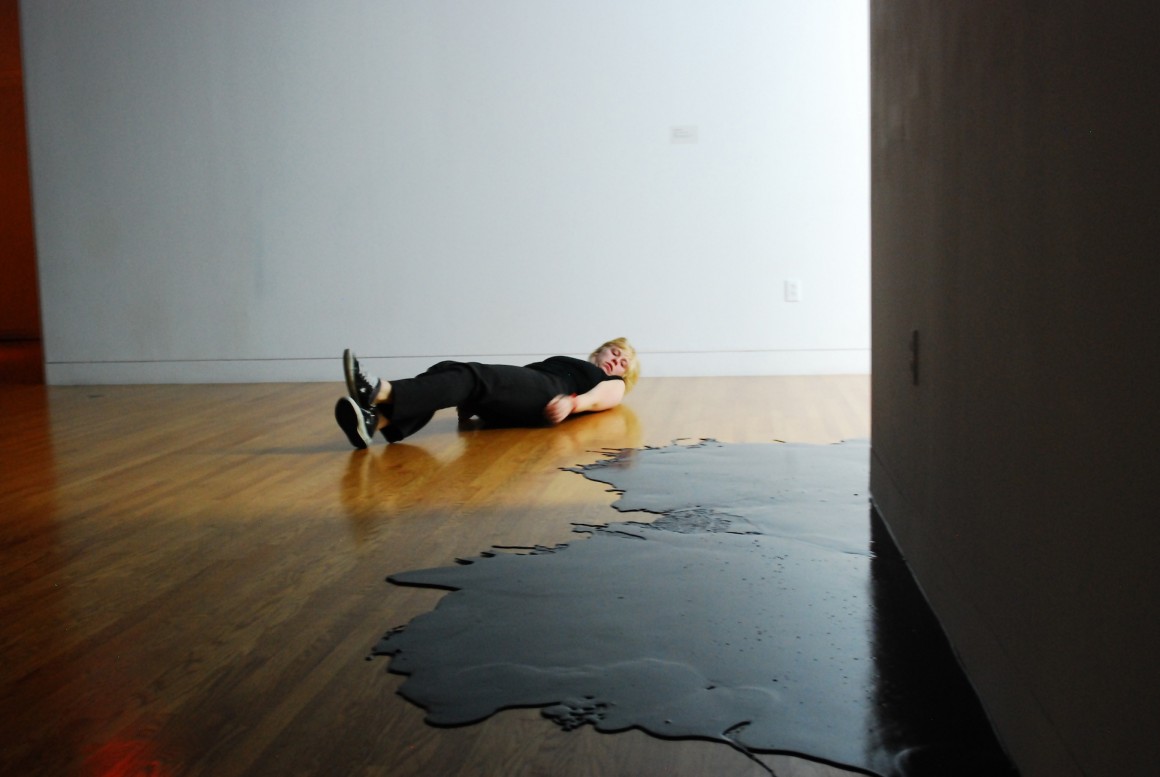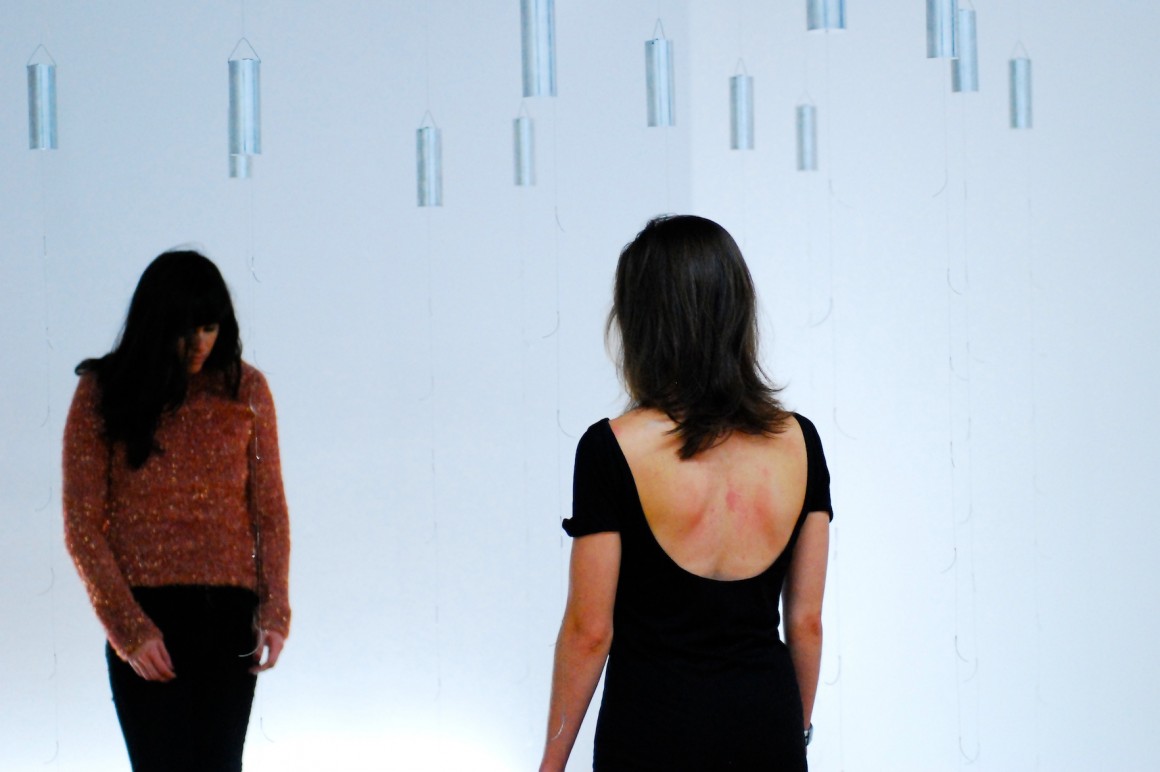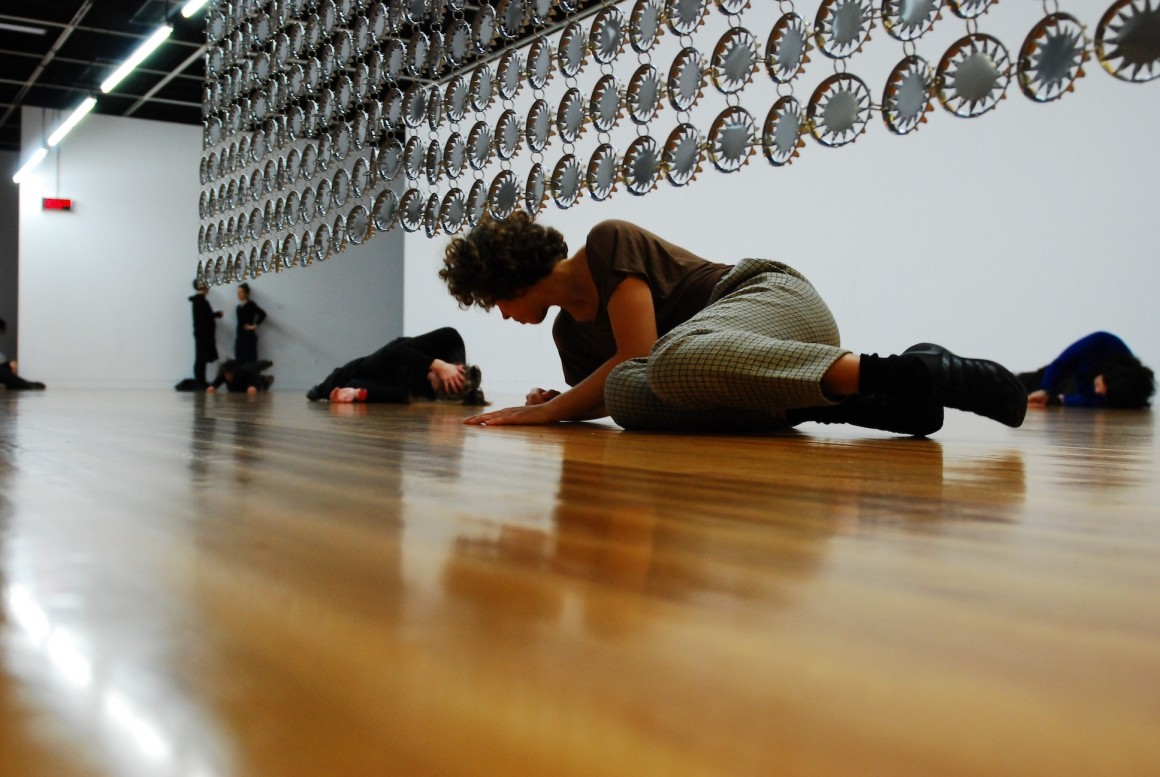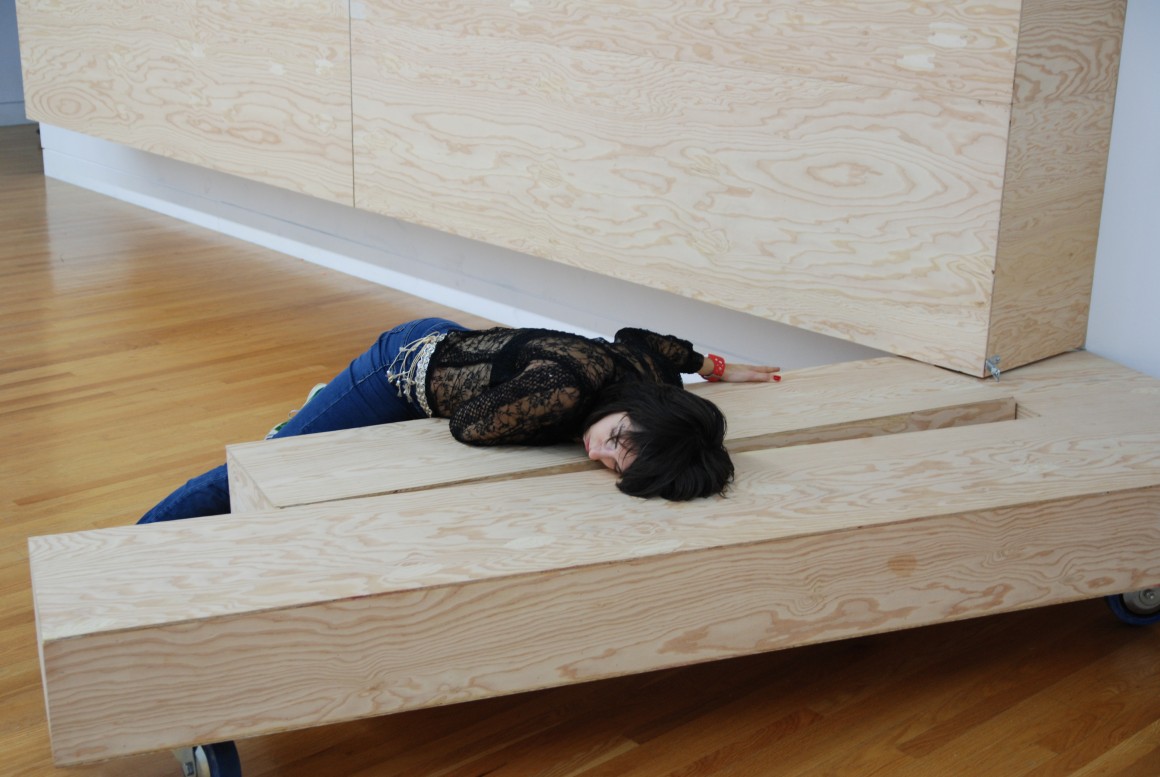Five spaces, five weeks, five performers and five visual artists
Montreal choreographer Lynda Gaudreau has developed a project for the Gallery’s exhibition spaces. This hybrid and experimental project, at the borders of choreography and exhibition making is at once a choreographed exhibition and an exhibited choreography that questions the nature and relationship of these practices.
What might an exhibition beginning with dance and ending with visual art be? From its opening to its closing, how does the exhibition space include the living body? How does this body coexist with the artworks in the contested space of the gallery?
In and with the space itself, OUT OF GRACE, employs choreographic tools in rethinking the white cube. Choreography is not restricted to the body but also addresses the organization and continual construction of space. Visual artists have been invited to create works over the five weeks during which the exhibition takes place, thus encouraging the public to visit the gallery repeatedly. Over time the works and the exhibition spaces will be transformed, as will the visitor’s experience.
Read moreOUT OF GRACE is both dynamic and playful. Elementary devices such as sound, lighting and the presence of the body draw the visitor in and activate modes of display and perception, addressed here according to a performative and compositional logic. What is entailed by these modes when works coexist with the body? How does experiencing sound, lighting, their activation and deactivation become a tool to sharpen our perception? Little by little, the white space of the Gallery is filled by intensities, by a noise that immerses it in silence, in a dense and mute experience of the body, the object and space.
CloseEXPLORE
- Time and its importance in Out of Grace. How is time organized here and what cues, sequences, rhythms are you able to discern that provide clues to the temporal structure of this project?
- The workings of space in this project. Reflect on the numerous ways in which it is created, made use of, and transformed.
- The notions of performance and performativity. How might they apply to Out of Grace and what is being accomplished here? Consider the performers, the artworks, the lighting, and the sound. How do each of these contribute to the performance or the performative nature of this project?
- The positioning of the artworks in this project in terms of how they interact with the sound, the lighting, the bodies that are all simultaneously present in the Gallery and what effect do these elements have on them?
- The choreographic score. Such a document exists for this project. Reflect on all of the elements that might be included in such a document, what it might ultimately look like, and how it might be read or interpreted.
- The ways in which each of the artworks presented in Out of Grace is an integral part of this choreographic score.
Produced with the support of the Frederick and Mary Kay Lowy Art Education Fund.
A project in five phases by Lynda Gaudreau
Coproduced by the Leonard & Bina Ellen Art Gallery and Lynda Gaudreau | Compagnie De Brune
Artists: Alexandre David, Jérôme Fortin, Aude Moreau, Yann Pocreau and Chih-Chien Wang
Performers: Karina Iraola, Anne Thériault, Émilie Morin, Amélie Bédard-Gagnon, Marilyne St-Sauveur
Intern-performers: Josianne Latreille, Josiane Fortin, Anouk Thériault, Élise Bergeron, Marie-Pier Bazinet, Corinne Crane-Desmarais, Nancy Rivest, Catherine Lepage, Karenne Gravel, Chantal Hausler, Andrée-Anne Ratthé, Eugénia Khoury, Chloe Millsop-Melançon, Raphaëlle Perreault, Amélie Rajotte, Gabrielle Surprenant-Lacasse
Extras: Jeanne Dubé-Blanchet, Ariane Dubé-Lavigne, Anne Trudel, Eve Leclair, Olivia Lathuilliere, Marie-Pier Morin, Renée-Anne Patenaude-Blais
Creative Assistance: Matteo Fargion and Anne Thériault
Lighting: Alexandre Pilon-Guay
Sound Design: Alexandre St-Onge
The Artists
Alexandre David lives and works in Montreal. He works mainly in the field of sculpture, and his projects often refer to architecture. His work has been shown in various museums and galleries in Canada, the United Kingdom, the Netherlands and France. He has exhibited his work in solo exhibitions at Optica and Dare-Dare in Montreal and La Chambre Blanche in Quebec City in 2007 and, in 2009, at Aceartinc in Winnipeg and Grunt in Vancouver. In 2011, he will be presenting solo exhibitions at YYZ in Toronto, Espace Tilt in Lausanne, Plein Sud in Longueuil, and the Parisian Laundry in Montreal.
Our everyday architectural sensations are a necessary background for my sculptural work. I don’t reference architecture as such, but I make work that relies on the ways in which we walk through doorways with ease, walk alongside walls, turn corners and sit on benches. I work with standard heights of ceilings, tables, benches and steps. Some of my works are intended to function as interior courts or squares. I often try to create an architectural sense of space through the experience of a self-contained object and I blur the boundaries between public and private space, between a space one can only look at and a space that one can move around in.
I like the idea of making work that reorganizes a space for a short period of time. The combination of a very clear architectural experience with the sense of the work being one possibility among others, as if I was working through ideas and putting something up momentarily, can give the work an anti-monumental quality despite it’s considerable scale.
THE WORK
Untitled, 2010
Objects on the gallery wall and floor, when deployed, will create a space through which visitors can move; when closed, these same objects will act more as a wall-mounted work of art. The project, in keeping with the rest of my artistic practice, seeks to generate a space that defines itself through the use of objects.
ADDITIONAL SOURCES OF INFORMATION
Chagnon, Katrie. Les lieux de passage d’Alexandre David. Esse 61, 2007: 62-65.
Fraser, Marie. La demeure. Montréal: Optica, 2008.
Godmer, Gilles. Alexandre David. Montréal: Musée d’art contemporain de Montréal, 2002.
Tousignant, Isa. Woodworkers: Alexandre David, Stéphane La Rue and Québec’s new minimalism. Canadian Art 25.1, 2008: 44-48.
CloseJérôme Fortin was born in Joliette in 1971, he lives and works in Montreal. Since 1996 he has had more than a dozen solo exhibitions including shows in Prague, Pretoria, Tokyo, Paris, Toronto and Montreal. His work has been presented in group exhibitions in Istanbul, Berlin, Bologna, Brussels, Paris, Cuba, Barcelona, Beijing and New York. Fortin has also actively participated in international artists’ residencies, notably at the World Financial Center Arts and Events (New York), la Fondation Christoph-Merian (Basel), Fonca (Mexico D.F.), la Cité internationale des arts (Paris), the Ludwig Foundation of Cuba (Havana) and Tokyo Wonder Site (Tokyo).
In his sculpture-installations, Fortin combines the cabinet of curiosities (private museums of the 16th century) with the mass consumption of the 20th and 21st centuries. Corks, plastic bottles, books, matches, nails and tin cans are cleverly assembled as multiple series of visual and malleable curiosities. He uses these objects for their specific forms, colours and textures, his sculptures evoking the flowers, shells, jewellery, and amulets once collected for their exotic appeal by the curious. The poetic and indeed enigmatic appearance of Fortin’s sculptures counter the conventional view of these everyday objects, piquing our contemporary interest in them.
THE WORK
Continuum, 2010
Continuum is the second version of a work presented at Pierre-François Ouellette Art Contemporain in the winter of 2010. Here the work, an homage to American composer Morton Feldman, will become a constellation inspired by the works of Ghanian artist El Anatsui. It marks the formal pursuit of an ambitious project begun more than a year ago.
ADDITIONAL SOURCES OF INFORMATION
Arbour, Rose-Marie. Jérôme Fortin: éloge de la fragilité et des croisements. Espace 62: 45-46.
Chrillesen, Neel. Fortin, Revue de détail. Cimaise 54: 65-7.
Gascon, France. Ici et là – Here and There. Joliette: Musée d’art de Joliette, 2002.
Grant Marchand, Sandra. Jérôme Fortin. Montréal: Musée d’art contemporain de Montréal, 2007.
CloseAude Moreau lives and works in Montreal. She has exhibited her work in Quebec, France, the U.S., and Luxemburg. Among her most recent solo exhibitions are Faire le vide (Plein sud, 2010), Tirer le ciel (Luxemburg Casino Contemporary Art Forum, 2009), and Tapis de sucre 3 (Darling Foundry, 2008). She has also contributed to group exhibitions that include Art souterrain – Nuit blanche de Montréal (2010), La Biennale Nationale de Sculpture Contemporaine de Trois-Rivières (2010), and Orange événement d’art actuel de Saint-Hyacinthe (2006).
Aude Moreau focuses on formally structuring solids and voids to examine the prescriptive structures that define our living spaces and dwellings. The interweaving of utilitarian and functionalist data generated by her production and assigned an aesthetic order underscores the vacuousness of the objective quantification constructed by our day-to-day lives. Her practice comprises a body of diverse works that include performances, in situ offerings, installations and video works.
THE WORK
caution slippery floor, 2010
The invitation extended by choreographer Lynda Gaudreau to contribute to the gallery space prompted me to consider a project based on how the floor is employed. On the one hand, the gallery floor physically supports choreographic movement, and, on the other hand, it defines the path taken by all manner of cultural workers, visitors, dancers and artists. I feel it demands an examination of our grounding in the present. Over the exhibition’s five week run, the work will increasingly take over the floor, interfering with the steps taken by those crossing it and gradually changing the routes they trace.
ADDITIONAL SOURCES OF INFORMATION
Roy, Christian. La violence et le sucré. Esse 65, 2009: 26-29.
Schütze, Bernard. Refinement Vacuum. Espace sculpture 85, 2008: 43-44.
Schütze, Bernard. Le dedans et le dehors de la couleur. Galerie B-312, Cahier 83, 2004.
Tanasescu Marius. La critique de la (dé)raison cathodique. Longueuil: Les opuscules de Plein sud, 2010.
CloseYann Pocreau was born in Quebec City in 1980. He now lives and works in Montreal. Active primarily in the photographic domain, Pocreau has participated in many individual and group exhibitions in Canada and Europe. He also writes for a number of magazines, galleries and artist-run centres. His upcoming work is the catalogue for the exhibition Gwenaël Bélanger: Casser l’image, which he curated. His works are part of the permanent collection of the Montreal Museum of Fine Arts, the Prêt d’œuvres d’art collection of the Musée national des beaux-arts du Québec, the National Bank of Canada collection, the Hydro-Québec collection, and many private collections. Since 2009, he has been the coordinator of the Centre d’art et de diffusion CLARK. He is also a board member for the RCAAQ and since 2007 has been on the editorial board of esse arts + opinions.
Yann Pocreau’s photographic practice explores the powerful presence of subject and site and their close interconnectedness. Through various physical interventions, he attempts to develop an empathetic relationship with space, to underscore glimpses of its latent history, its context. His photographic work reflects his growing interest in the possible and impossible relationships between bodily states and a chosen site. This choice, frequently determined by the narrative, historical, political or photographic potential of a given site, is now presented in a much clearer fashion, a given choice, guided by its source: a context. Through physical interventions, formal strategies, and stagings, Pocreau attempts to reveal this, to establish contact with this context. Natural light is crucial for Pocreau’s. In addition to being omnipresent in his work and stagings, it enlivens chosen sites, marking details, magnifying the surfaces of walls or the body. It is a guide that the body must follow to cut through the space, to bend to it and to encompass it.
THE WORK
Surfaces, 2010
When invited by a choreographer to participate in this project, I immediately began to reflect on a shift that would take place between the wall, the surface on which my exhibitions take place, and the floor, the natural surface for dance. I began work on these shifts, this transfer, on the possible overlaps and the impossible pairings. Photosensitive surfaces, those of works that I hang, and the performance floor have all been approached as a system in motion, constantly interacting. I wanted this work to be governed by a inflexible grid, which, day by day, would lead to a total shifting of the exhibition parameters, indeed to the disappearance of the image into the architecture supporting it.
ADDITIONAL SOURCES OF INFORMATION
Beaupré, Marie-Ève. In Review: Yann Pocreau. Canadian Art, 2008: 163.
Denault, Karine. Yann Pocreau: En dialogue avec la lumière. Ovni 04, 2010: 20-26.
Hersant, Isabelle. L’image, le corps, le lieu. www.lacritique. 2008.
St-Jean Aubre, Anne Marie. Compte-rendu de l’exposition les dialogues acrobatiques. Ciel Variable 80, 2008-2009: 73-74.
CloseBorn in Taiwan, Chih-Chien Wang has been living in Montreal since 2002. He obtained a BFA from the Chinese Culture University in Taipei in 1994. He worked for several television companies producing documentaries before moving to Canada and obtaining his MFA in Studio Arts at Concordia University in 2006. Wang’s works have been presented in Montréal, Lausanne, Milan, New York, Ping Yao, Peterborough, Toronto, Calgary, Boston, Miami and Beijing.
My work deals primarily everyday experiences and frequently contains subtle references to personal, cultural or social concerns. My art practice involves the process of collecting, recreating, and presenting found objects. This process contributes to my understanding of living spaces and cultural diversity in the city. These concerns also resemble my understanding of people, reflect the place where I live in, and reveal my self-doubt. Photography, video, and installation are my main tools. They offer me diverse means for examining content and with them I am able to capture impressions of specific moments while recreating a kind of collective “scenery” generated from collected experiences. Since 2002 I have completed various projects focusing on personal surroundings, self-representation, community connections, and exploration of urban spaces.
THE WORK
Happening is recurrence, 2010
Happening is recurrence describes a space through time, movement, and repetition. It is an installation composed of suspended, spinning objects that create repetitive movements and a programmed record-and-playback video system that documents and presents the installation at specific intervals. Visitors are invited interact with the suspended objects, propelling them into motion. The movement of these objects is continuously recorded and projected, creating a play between live and delayed video documentation of the installation in motion. Repetition underlines and calls into question notions of space and time.
ADDITIONAL SOURCES OF INFORMATION
Bonnes, Clara. Durability and Fragility: Two Distinct Positions. Esse 65, 2009: 16-21.
Campeau, Sylvain. Données contradictoires. ETC 80, 2007: 39-45.
Dion, François. Combinaisons. Spirale 215, 2007: 32-33.
Jim, Alice Ming Wai. Domestic Trajectories. CV Ciel Variable 71, 2006: 13-14.
Ragubance, Anil. The Poetics of Empty Hands. www.artspace.com. 2006.
Close













